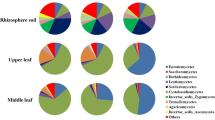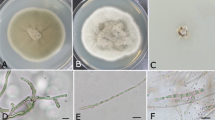Abstract
Endophytic fungi are characterized as microorganisms found within internal tissues of living plants without any immediate, overtly negative effects. The present study was carried out to isolate, taxonomically characterize and determine the spatiotemporal distribution of endophytic fungi associated with leaf, stem, trunk, and root of mandarin (Citrus reticulata cv. Siyahoo). To do so, the sampling program was done seasonally in four geographically isolated mandarin growing areas of Hormozgan province of Iran, including Siyahoo, Ahmadi, Sikhoran, and Roudan. In total, 702 fungal isolates were obtained from leaf, stem, trunk, and root of healthy mandarin trees divided into 26 distinct morphotypes based on morphological characteristics. The morphotypes were taxonomically characterized through phylogenetic analysis of the ITS1-5.8S-ITS4 rDNA region sequences. Accordingly, 10 different fungal orders from 5 fungal classes were identified, i.e., Saccharomycetes (Saccharomycetales), Eurotiomycetes (Eurotiales), Dothideomycetes (Capnodiales, Pleosporales, Dothideales), and Sordariomycetes (Diaporthales, Hypocreales, Microascales, Togniniales), all from Ascomycota, which represented 97.2% and Ustilaginomycetes (Ustilaginales) from Basidiomycota which represented 2.8% of the isolates. The Aureobasidium pullulans, Penicillium citrinum, and Dothideomycetes sp. were the most frequent isolates. The trunk and leaf showed the highest and lowest total colonization frequency and species richness of endophytic fungi, respectively, in all sampling periods. The results showed that the colonization frequency of endophytes in Hormozgan province was higher in autumn than that in spring, winter, and summer. The trunk showed the maximum diversity of endophytes over all seasons. The Shannon–Wiener (H′) and Simpson indices had significant correlation with sampling cites and tissue type and the maximum value of Shannon and Simpson indices (H′ = 3.05 and 1 − D = 0.94) was found in the specimens collected from Siyahoo. In conclusion, the three factors (season, location, and tissue type) all in together could determine fungal endophyte composition of C. reticulata.


Similar content being viewed by others
References
Aly AH, Debbab A, Kjer J, Proksch P (2010) Fungal endophytes from higher plants: a prolific source of phytochemicals and other bioactive natural products. Fungal Divers 4(1):1–16
Angelini P, Rubini A, Gigante D, Reale L, Pagiotti R, Venanzoni R (2012) The endophytic fungi communities associated with the leaves and roots of the common reed (Phragmites australis) in lake Trasimeno (Perugia, Italy) in declining and healthy stands. Fungal Ecol 5:683–693
Arnold AE, Henk DA, Eells RL, Lutzoni F, Vilgalys R (2007) Diversity and phylogenetic affinities of foliar fungal endophytes in loblolly pine inferred by culturing and environmental PCR. Mycologia 99:185–206
Cheplick GP, Faeth S (2009) Ecology and evolution of the grassendophyte symbiosis. Oxford University Press, Oxford
Childs J, Kopp L, Johnson R (1965) A species of Physoderma present in Citrus and related species. Phytopathol 55(6):681–687
Chomcheon P, Wiyakrutta S, Sriubolmas N, Ngamrojanavanich N, Mahidol C, Ruchirawat S, Kittakoop P (2009) Metabolites from the endophytic mitosporic Dothideomycete sp. LRUB20. Phytochem 70(1):121–127
Clay K, Shearin ZR, Bourke KA, Bickford WA, Kowalski KP (2016) Diversity of fungal endophytes in non-native Phragmites australis in the Great Lakes. Biol invasions 18(9):2703–2716
Collado J, Platas G, Gonzalez I, Pelaez F (1999) Geographical and seasonal influences on the distribution of fungal endophytes in Quercus ilex. New Phytol 144:525–532
Douanla-Meli C, Langer E (2012) Diversity and molecular phylogeny of fungal endophytes associated with Diospyros crassiflora. Mycology 3:175–187
Douanla-Meli C, Langer E, Mouafo FT (2013) Fungal endophyte diversity and community patterns in healthy and yellowing leaves of Citrus limon. Fungal Ecol 6:212–222
Duran EL, Ploper LD, Ramallo JC, Piccolo Grandi RA, Hupper Giancoli AC, Azevedo JL (2005) The foliar fungal endophytes of Citrus limon in Argentina. Can J Bot 83:350–355
Dutta T, Sahoo R, Sengupta R, Ray SS, Bhattacharjee A, Ghosh S (2007) Novel cellulases from an extremophilic filamentous fungi Penicillium citrinum: production and characterization. J Ind Microbiol Biotechnol 35:275–282
El-Tarabily KA, Sivasithamparam K (2006) Potencial of yeast as biocontrol agents of soil-borne fungal plant pathogens and as plant growth promoters. Mycoscience 47:25–35
Glienke-Blanco C, Aguilar-Vildoso CI, Vieira MLC, Barroso PAV, Azevedo JL (2002) Genetic variability in the endophytic fungus Guignardia citricarpa isolated from citrus plants. Genet Mol Biol 25(2):251–255
Golparyan F, Azizi A, Soltani J (2018) Endophytes of Lippia citriodora (Syn. Aloysia triphylla) enhance its growth and antioxidant activity. Eur J Plant Pathol 152:759–768
Guo LD, Huang GR, Wang Y (2008) Seasonal and tissue age influences on endophytic fungi of Pinus tabulaeformis (pinaceae) in the dongling mountains, Beijing. J Int Plant Biol 50(8):997–1003
Hamayun M, Khan SA, Iqbal I, Ahmad B, Lee IJ (2010) Isolation of a gibberellin-producing fungus (Penicillium sp. MH7) and growth promotion of crown caisy (Chrysanthemum coronarium). J Microbiol Biotechnol 20:202–207
Hamilton C, Gundel PE, Helander M, Saikkonen K (2012) Endophytic mediation of reactive oxygen species and antioxidant activity in plants: a review. Fungal Divers 54:1–10
Helander ML, Sieber TN, Petrini O, Neuvonen S (1994) Endophytic fungi in Scots pine needles: spatial variation and consequences of simulated acid rain. Can J Bot 72(8):1108–1113
Hoffman M, Arnold AE (2007) Geographic locality and host identity shape fungal endophyte communities in cupressaceous trees. Mycol Res 112:331–344
Khan SA, Hamayun M, Yoon H, Kim HY, Suh SJ, Hwang SK, Kim JM, Lee IJ, Choo YS, Yoon UH, Kong WS (2008) Plant growth promotion and Penicillium citrinum. BMC Microbiol 8(1):231
Larget B, Simon DL (1999) Markov chain Monte Carlo algorithms for the Bayesian analysis of phylogenetic trees. Mol Biol Evol 16:750–759
Lee JS, Lee HK, Hur JS, Andreev M, Hong SG (2008) Diversity of the lichenized fungi in King George Island, Antarctica, revealed by phylogenetic analysis of partial large subunit rDNA sequences. J Microbiol Biotechnol 18:1016–1023
Linnakoski R, Puhakka-Tarvainen H, Pappinen A (2012) Endophytic fungi isolated from Khaya anthotheca in Ghana. Fungal Ecol 5:298–308
Lockwood JL (1981) Exploitation competion. In: Wicklow DT, Carrol GC (eds) The fungal community: its organization and role in ecosystem. Marcel Dekker, New York, pp 319–349
Martini M, Musetti R, Grisan S, Polizzotto R, Borselli S, Pavan F, Osler R (2009) DNA-dependent detection of the grapevine fungal endophytes Aureobasidium pullulans and Epicoccum nigrum. Plant Dis 93:993–998
Martins F, Pereira JA, Bota P, Bento A, Baptista P (2016) Fungal endophyte communities in above-and belowground olive tree organs and the effect of season and geographic location on their structures. Fungal Ecol 20:193–201
Mitchell AM, Strobel GA, Hess WM, Vargas PN, Ezra D (2008) Muscodor crispans, a novel endophyte from Ananas ananassoides. in the Bolivian Amazon. Fungal Divers 31:37–43
Nylander JAA (2004) MrModeltest V2. Evolutionary Biology Centre, Uppsala University, Uppsala
Ownley HB, Gwinn DK, Vega EF (2010) Endophytic fungal entomopathogens with activity against plant pathogens: ecology and evolution. Biocontrol 55:113–128
Pakvaz S, Soltani J (2016) Endohyphal bacteria from fungal endophytes of the Mediterranean cypress (Cupressus sempervirens) exhibit in vitro bioactivity. For Path 46:569–581
Pancher M, Ceol M, Corneo EC, Longa CMO, Yousaf S, Pertot I, Campisano A (2012) Fungal endophytic communities in Grapevines (Vitis vinifera L.) respond to crop management. Appl Environ Microbiol 78:4308–4317
Photita W, Lumyong S, Lumyong P, Hyde KD (2001) Endophytic fungi of wild banana (Musa acuminata) at Doi Suthep Pui National Park, Thailand. Mycol Res 105:1508–1513
Rodrigues KF (1994) The foliar fungal endophytes of the Amazonian palm Euterpe oleracea. Mycologia 86:376–385
Ronquist F, Huelsenbeck JP (2003) MrBayes 3: Bayesian phylogenetic inference under mixed models. Bioinformatics 19:1572–1574
Schena L, Ippolito A, Zahavi T, Cohen L, Nigro F, Droby S (1999) Genetic diversity and biocontrol activity of Aureobasidium pullulans isolates against postharvest rots. Postharvest Biol Technol 17:189–199
Schena L, Nigro F, Pentimone I, Ligorio A, Ippolito A (2003) Control of postharvest rots of sweet cherries and table grapes with endophytic isolates of Aureobasidium pullulans. Postharvest Biol Technol 30:209–220
Schulthess FM, Faeth SH (1998) Distribution, abundances and association of the endophytic fungal community of Arizona fescue (Festuca arizonica). Mycologia 90:569–578
Shannon CE, Weaver W (1963) The mathematical theory of communication. University of Illinois Press, Urbana
Simpson GG (1964) Species density of North American recent mammals. Syst Zool 13:57–73
Slippers B, Wingfield MJ (2007) Botryosphaeriaceae as endophytes and latent pathogens of woody plants: diversity, ecology and impact. Fungal Biol Rev 21:90–106
Soltani J (2017) Endophytism in Cupressoideae (Coniferae): a model in endophyte biology and biotechnology. In: Maheshwari D (ed) Endophytes: biology and biotechnology. Sustainable development and biodiversity, vol 15. Springer, Cham, pp 127–143
Soltani J, Zaheri Shoja M, Hamzei J, Moghaddam SH, Pakvaz M S (2016) Diversity and bioactivity of endophytic bacterial community of Cupressaceae. For Path 46:353–361
Soltani J, Moghaddam MSH (2015) Fungal endophyte diversity and bioactivity in the mediterranean cypress Cupressus sempervirens. Curr microbiol 70(4):580–586
Sugita T, Nishikawa A (2003) Fungal identification method based on DNA sequence analysis. Reassessment of the methods of the pharmaceutical society of Japan and the Japanese pharmacopoeia. J Health Sci 49:531–533
Sun X, Ding Q, Hyde KD, Guo LD (2012) Community structure and preference of endophytic fungi of three woody plants in a mixed forest. Fungal Ecol 5:624–632
Tadych M, Bergen MS, Johnson-Cicalese J, Polashock JJ, Vorsa N, White JF Jr (2012) Endophytic and pathogenic fungi of developing cranberry ovaries from flower to mature fruit: diversity and succession. Fungal Divers 54:101–116
Vega FE, Simpkins A, Aime MC, Posada F, Pehner SA, Infante F, Castillo A, Arnold AE (2010) Fungal endophyte diversity in coffee plants from Colombia, Hawaii, Mexico and Puerto Rico. Fungal Ecol 3:122–138
Wakiyama M, Tanaka H, Yoshihara K, Hayashi S, Ohta K (2008) Purification and properties of family-10 endo-1,4-β-xylanase from Penicillium citrinum and structural organization of encoding gene. J Biosci Bioeng 105(4):367–374
Wearn JA, Sutton BC, Morley NJ, Gange AC (2012) Species and organ specificity of fungal endophytes in herbaceous grassland plants. J Ecol 100(5):1085–1092
White TJ, Bruns T, Lee S, Taylor J (1990) Amplification and direct sequencing of fungal ribosomal RNA genes for phylogenetics. In: Innis MA, Gelfand DH, Sninsky JJ, White TJ (eds) PCR protocols: a guide to methods and applications. Academic Press, San Diego, pp 315–322
Yuan Z, Zhang C, Lin F, Kubicek CP (2010) Identity, diversity, and molecular phylogeny of the endophyticmycobiota in the roots of rare wild rice (Oryza granulate) from a nature reserve in Yunnan, China. Appl Environ Microbiol 76:1642–1652
Zabalgogeazcoa I (2008) Fungal endophytes and their interactions with plant pathogens. Spanish J Agric Res 6:138–146
Zabalgogeazcoa I, Gundel P, Helander M, Saikkonen K (2013) Nonsystemic fungal endophytes in Festuca rubra plants infected by Epichloe festucae in subarctic habitats. Fungal Divers 60:25–32
Zhang D, Yang Y, Castelbury LA, Cerniglia CE (1996) A method for large scale isolation of high transformation efficiency genomic DNA. FEMS Microbiol Lett 145:261–226
Acknowledgements
This research was supported by the research grant from University of Hormozgan, Iran, to Fatemeh Sadeghi in 2017.
Author information
Authors and Affiliations
Corresponding author
Ethics declarations
Conflict of interest
The authors declare that they have no conflict of interest.
Additional information
Publisher’s Note
Springer Nature remains neutral with regard to jurisdictional claims in published maps and institutional affiliations.
Rights and permissions
About this article
Cite this article
Sadeghi, F., Samsampour, D., Seyahooei, M.A. et al. Diversity and Spatiotemporal Distribution of Fungal Endophytes Associated with Citrus reticulata cv. Siyahoo. Curr Microbiol 76, 279–289 (2019). https://doi.org/10.1007/s00284-019-01632-9
Received:
Accepted:
Published:
Issue Date:
DOI: https://doi.org/10.1007/s00284-019-01632-9




